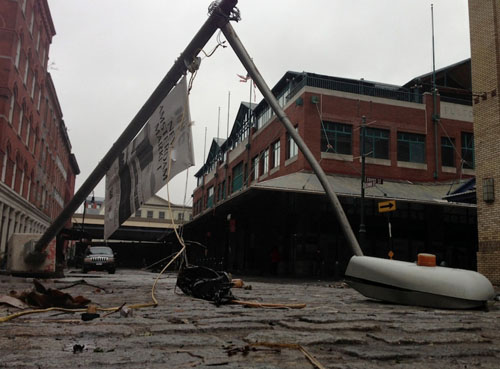Now, local officials and real-estate experts say that revitalization looks uncertain. Sandy has decimated most of the buildings, including the South Street Seaport Museum, and may have caused structural damage to Pier 17, on which the Howard Hughes Corp. planned to redevelop a large mall as an attraction.
Stores are expected to be closed for months, a number of them until the spring. Brokers and officials fear that by the time they reopen, the neighborhood will be further forgotten by locals and avoided by tourists.
"For a project that has had so many generations of setbacks, I think this is an even bigger setback than we know," said Faith Hope Consolo, chairman of Prudential Douglas Elliman's retail group. "For the first time, I think the South Street Seaport may really sink."
On a recent morning, the seaport was even more quiet than usual as workers in white suits hauled debris from buildings into containers lining Fulton Street. Almost all of South Street Seaport's shops, restaurants and tourist attractions were closed. The windows of chains such as Gap, Guess and Abercrombie & Fitch were boarded up or clouded over with steam, while small-business owners worked to clean up.
Pier 17 is blocked off to pedestrians by rows of metal gates as divers check on the piles that sit under the pier to see whether they were damaged.
"We are currently evaluating whether Pier 17 is structurally sound," said a spokesman for Howard Hughes in a statement. He said the mall itself wasn't flooded, so the pier could reopen by the end of the year if it is found to be structurally sound.
Pending public approval, Howard Hughes had planned to begin redeveloping the mall in 2013 and to open in 2015. The spokesman said Sandy wouldn't affect that timeline.
But real-estate experts nonetheless said the storm would make the redevelopment more challenging. If stores are closed for months and the mall is then closed for two years due to construction, it could be difficult to attract visitors. Retailers might also be hesitant to sign leases in an area seen as vulnerable to flooding.
"People have a short time span to remember. When they remember the seaport, they'll remember all those stores being closed," Ms. Consolo said.
Another important attraction, the South Street Seaport Museum, estimates that repairs will cost nearly $22 million-a huge blow for an institution that was on precarious financial footing before the storm. Although the museum's tall ships survived the storm, floodwaters knocked out all of its mechanical systems.
The museum's flood insurance policy covers $500,000. It is applying to the Federal Emergency Management Agency for aid, and its landlord, the city's Economic Development Corp., said it will cover repairs to the museum's electrical panels and sprinklers.
"It is kind of shocking," said Susan Henshaw Jones, the museum's president. The equipment, which was in the basement, must be replaced and relocated, adding to the cost.
The museum plans to reopen Dec. 14, using a generator and kerosene-fueled heaters in the lobby and on the third and fourth floors. Visitors will have to take the stairs to the galleries.
Aside from the daunting cost of repairs, the museum's operating budget will take a hit from its closure and decreased foot traffic once it reopens.
Ms. Jones said she is optimistic about the museum's ability to adapt in the short-term-and heartened by an outpouring of volunteer help and $130,000 in post-Sandy donations-but less confident about the museum's prospects for funding the needed equipment. "I'm concerned about 2013 and 2014," she said.
Most of the businesses and attractions in the area have similar concerns.
"Lots of businesses were just devastated. The cleanup is expensive and in some cases very slow. With the reopening store by store, sometimes you find fewer customers than you had before," said state Sen. Daniel Squadron, who represents the area.
Small-business owners also said they needed chain stores to reopen in order to bring foot traffic back to the area, but many of them haven't been doing much visible clean-up work. Requests for comment to Gap, Ann Taylor and Abercrombie & Fitch weren't returned. A spokeswoman for Guess said the store is expected to open in mid-December.
"It seems like if anyone could afford to reopen immediately, it would be those big corporate stores. They have the deepest pockets for sure," said Maura Kilgore, the 43-year-old general manager of Cowgirl Seahorse.
Local officials likewise expressed frustration with the rate at which buildings, and larger stores in particular, have been reopening.
"We really need to use whatever leverage we have to get the developer and chain stores to get back into business," said Margaret Chin, the City Council member who represents the area. She said Howard Hughes, which owns a number of buildings in the area, will need to appear before the council to seek approval for its Pier 17 project.
"Before they talk about the new plan, we need to talk about how are we going to get everything back up and running now," Ms. Chin said.
Howard Hughes said many of its area buildings sustained "significant flooding and other damage," and it is evaluating the extent of structural, mechanical, electrical and environmental damage. "This is an ongoing process which we are diligently pursuing," said a spokesman.
But glimmers of activity have started to appear. A handful of restaurants have reopened. The Artion Galleries is going ahead with its grand opening next week as planned. "We still feel it's great because the neighborhood after so much devastation needs that connection," said Carmen Molina, whose photography is being exhibited.












 The South Street Seaport was recently on the verge of a major redevelopment designed to lure locals and more tourists to the charming, but largely ignored, neighborhood on the southeast tip of Manhattan.
The South Street Seaport was recently on the verge of a major redevelopment designed to lure locals and more tourists to the charming, but largely ignored, neighborhood on the southeast tip of Manhattan.